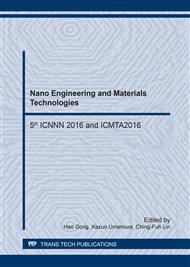p.74
p.81
p.86
p.91
p.97
p.102
p.111
p.117
p.122
Investigating the Deformation, Breakage and Number on Conductive Particle of Flim-on-Glass Packaging Using Anisotropic Conductive Film Bonding
Abstract:
Anisotropic conductive film (ACF), is a lead-free material that is commonly used in fine-pitch interconnect manufacturing to make and maintain the electrical and mechanical connections between the micro-electrodes. A key issue about the circuit conductivity is the deformation, breakage, and number of conductive particles in the ACF packaging. For the field of vision, the Film-On-Glass (FOG) assembly on the glass-side is used to obtain excellent images in experimental observation. This paper utilizes the microscope technology to investigate the bonding properties of the conductive particles, and consider the electrical resistance effects after packaging. The results show the deformation shape, breakage type, and number of conductive particles will be quantitatively affect the electrical performances, and one can measure the area, diameter, and roundness of the deformed particles’ projection in the glass-side view to evaluate the ACF packaging quality.
Info:
Periodical:
Pages:
97-101
Citation:
Online since:
March 2017
Authors:
Keywords:
Price:
Сopyright:
© 2017 Trans Tech Publications Ltd. All Rights Reserved
Share:
Citation:


